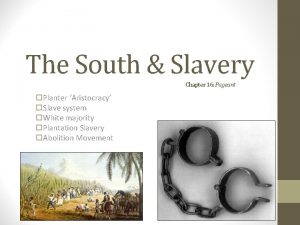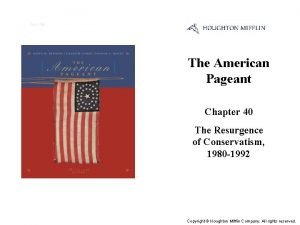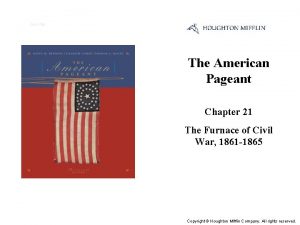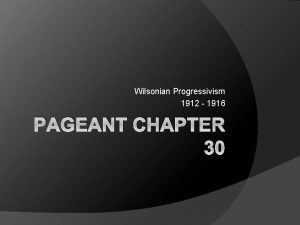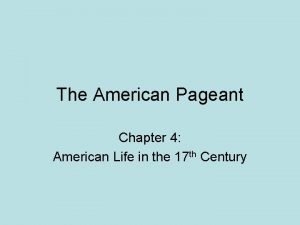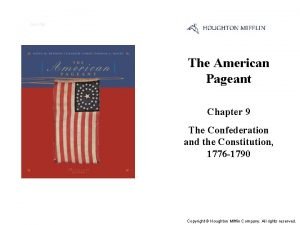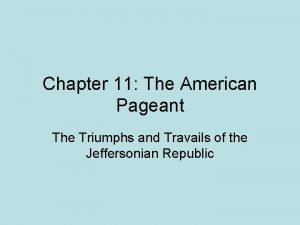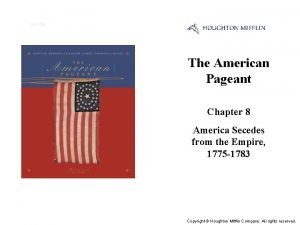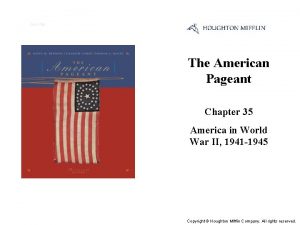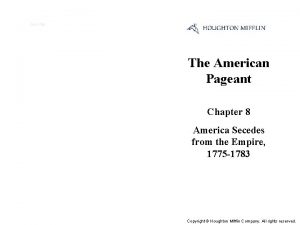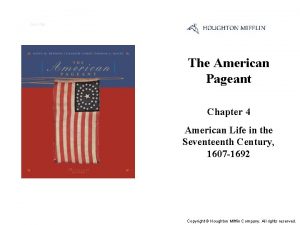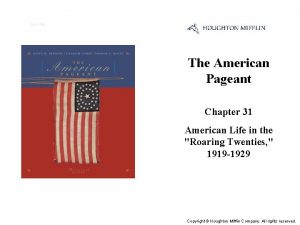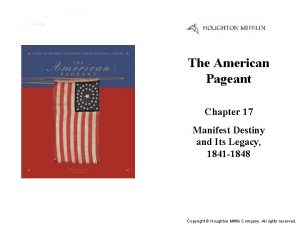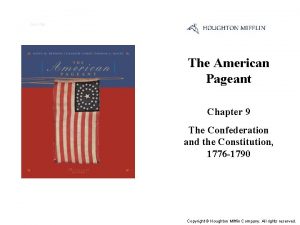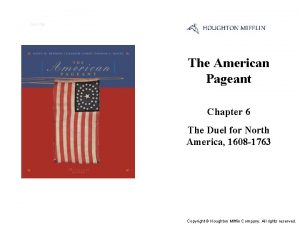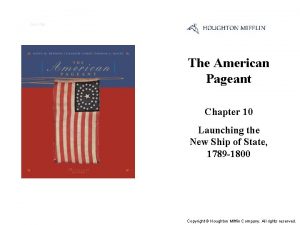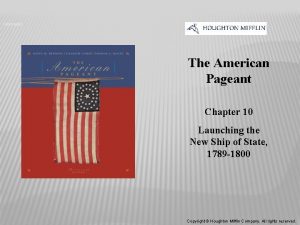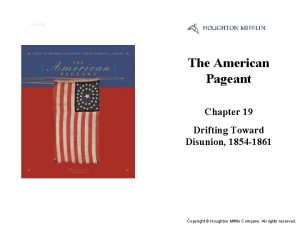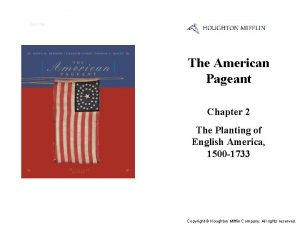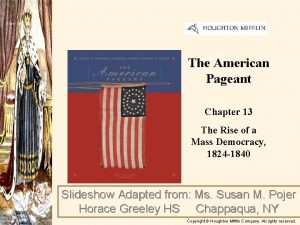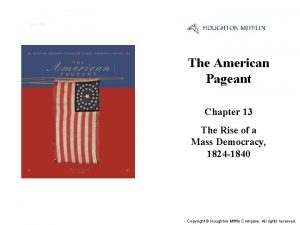Cover Slide The American Pageant Chapter 8 America





















- Slides: 21

Cover Slide The American Pageant Chapter 8 America Secedes from the Empire, 1775 -1783 Copyright © Houghton Mifflin Company. All rights reserved.

A Rare View of a Black Woodcutter at Work in Shelburne, Nova Scotia, by William Booth, 1788 Black loyalists who settled in Nova Scotia faced serious racial discrimination and open hostility from white refugees. This woodcutter may have been among the African-American loyalists who chose to relocate to Sierra Leone in the 1790 s. (National Archives Canada, Ottawa, C-40162) Copyright © Houghton Mifflin Company. All rights reserved.

Battle of Princeton by James Peale At the Battle of Princeton in early 1777, American forces under George Washington cemented the victory they had won a few days earlier at Trenton. This view was painted in 1787 by James Peale, who fought in the battle. (Princeton University Library) Copyright © Houghton Mifflin Company. All rights reserved.

Eighteenth-century British military kettledrum, surrendered at Saratoga This kettledrum belonged to the band of the Royal Norfolk Regiment, a British infantry unit that surrendered to the Americans at Saratoga. The drum was sent to West Point, where it has remained ever since, a symbol of the new nation's first great victory of the Revolution. (The West Point Museum Collection, U. S. Military Academy, West Point, New York. Photo by Paul Warchal. ) Copyright © Houghton Mifflin Company. All rights reserved.

Eighteenth-century medicine chest Measles, typhus, diphtheria, dysentery, and other diseases ravaged military encampments, making medicine chests like the one shown here essential equipment for the army. Doctors used crude remedies that often did more harm than good, for little was known about the causes of such afflictions. Smallpox was one of the few epidemics that eighteenth-century doctors could combat; inoculation was known to be an effective preventive measure as early as the 1720 s. (The West Point Museum Collection, U. S. Military Academy, West Point, New York. Photo by Josh Nefsky. ) Copyright © Houghton Mifflin Company. All rights reserved.

George III by A. Ramsay, 1767 Although unsure of himself and emotionally little more than a boy upon his accession to the English throne, George III possessed a deep moral sense and a fierce determination to rule as well as to reign. (Indianapolis Musum of Art, The James E. Roberts Fund) Copyright © Houghton Mifflin Company. All rights reserved.

George Washington's copy of Common Sense That America's patriot leaders read Thomas Paine's inflammatory Common Sense soon after it was published in early 1776 is indicated by this first edition, owned by George Washington himself. (Boston Athenaeum) Copyright © Houghton Mifflin Company. All rights reserved.

Joseph Brant by Charles Willson Peale, 1797 Joseph Brant, the Iroquois leader who helped to persuade the Mohawks, Senecas, and Cayugas to support the British in the latter stages of the Revolution, as painted by Charles Willson Peale in 1797. (Independence National Historic Park Collection) Copyright © Houghton Mifflin Company. All rights reserved.

New Touch on the Times… By a Daughter of Liberty Living in Marblehead, 1779 Americans on the home front as well as in the front lines experienced crippling wartime hardships. This illustration of a female partisan holding a musket accompanied a poem by Molly Gutridge, whose theme was women's sacrifice and suffering in a seaport economy upset by war. (© Collection of the New York Historical Society) Copyright © Houghton Mifflin Company. All rights reserved.

Surrender of the British at Yorktown French naval power combined with American military savvy to produce the decisive defeat of the British. (Library of Congress) Copyright © Houghton Mifflin Company. All rights reserved.

Tarleton's Cavalrymen After the Battle of Cowpens 1781, by William Ranney In this painting patriots stand their ground against cavalrymen led by Lieutenant Banastre Tarleton in a 1781 skirmish near Cowpens. As the painting shows, black as well as white Americans supported the revolutionary cause in the South. (Collection of the State of South Carolina. Photo by Hunter Clarkson, Alt Lee, Inc. ) Copyright © Houghton Mifflin Company. All rights reserved.

The Flutist, Barzillai Lew, African American fifer and drummer Barzillai Lew, a free African American born in Groton, Massachusetts, in 1743, served in the Seven Years War before enlisting with patriot troops in the American Revolution. An accomplished fifer, Lew fought at the Battle of Bunker Hill. Like other freemen in the north, he cast his lot with the revolutionaries, in contrast to southern bondspeople, who tended to favor the British. (Courtesy of Mae Theresa Bonitto) Copyright © Houghton Mifflin Company. All rights reserved.

Thomas Paine Having arrived in the colonies less than two years earlier, Paine became a bestselling author with the publication of Common Sense in 1776. (Art Gallery, Williams Center, Lafayette College ) Copyright © Houghton Mifflin Company. All rights reserved.

Washington and Lafayette at Winter Quarters shows the commander and his friend, the young aristocrat from France, sharing a moment of conversation while soldiers huddle together around a fire at Valley Forge. While British officers enjoyed the social life of Philadelphia, General Washington, his officers, and his men suffered from inadequate food, supplies, firewood, and shelter in their winter encampment, a situation due, in part, to the corruption and greed of military suppliers and the incompetence of the quartermaster corps. (Stock Montage ) Copyright © Houghton Mifflin Company. All rights reserved.

Map: Campaign of 1777 The crucial campaign of 1777 was fought on two fronts: along the upper Hudson and Mohawk River valleys, and in the vicinity of Philadelphia. The rebels won in the north; the British triumphed--at least nominally--in the south. The capture of Philadelphia, however, did the redcoats little good, and they abandoned the city the following year. Copyright © Houghton Mifflin Company. All rights reserved.

Map: Cession of Tribal Lands, 1775 -1790 The land claims of the United States meant little as long as Indian nations still controlled vast territories within the new country's formal boundaries. A series of treaties in the 1780 s and 1790 s opened some lands to white settlement. Copyright © Houghton Mifflin Company. All rights reserved.

Map: Indian Land Cessions, 1768 -1799 During the last third of the eighteenth century, Native Americans were forced to give up extensive homelands throughout the eastern backcountry and farther west in the Ohio and Tennessee River valleys. Copyright © Houghton Mifflin Company. All rights reserved.

Map: The Burgoyne Campaign The defeat of General John Burgoyne and his army at Saratoga was a major turning point in the war. It led to the recognition of American independence by France and later by Spain and to a military alliance with both these European powers. This map shows American and British troop movement and the locations and dates of the Saratoga battles leading to the British surrender. Copyright © Houghton Mifflin Company. All rights reserved.

Map: The Second Southern Campaign, 1778 -1781 This map of the second attempt by Britain to crush the rebellion in the South shows the many battles waged in the Lower South before Cornwallis's encampment at Yorktown and his surrender there. This decisive southern campaign involved all the military resources of the combatants, including British, loyalist, French, and American ground forces and British and French naval fleets. Copyright © Houghton Mifflin Company. All rights reserved.

Map: The War in the South The southern war--after the British invasion of Georgia in late 1778 --was characterized by a series of British thrusts into the interior, leading to battles with American defenders in both North and South Carolina. Finally, after promising beginnings, Cornwallis's foray into Virginia ended with disaster at Yorktown in October 1781. Copyright © Houghton Mifflin Company. All rights reserved.

Map: The War in the West, 1776 -1782 Carolina militiamen drove attacking Cherokees far back into the Appalachians in 1776. George Roger Clark's victory at Vincennes in 1779 gave the United States effective control of the Ohio valley. In retaliation for their raids on New York and Pennsylvania, John Sullivan inflicted widespread starvation on the Iroquois by burning their villages and winter food supplies in 1779. Copyright © Houghton Mifflin Company. All rights reserved.
 American pageant chapter 16
American pageant chapter 16 The american pageant chapter 35
The american pageant chapter 35 Chapter 40 american pageant
Chapter 40 american pageant American pagent chapter 21
American pagent chapter 21 American pageant chapter 14
American pageant chapter 14 American pageant chapter 13
American pageant chapter 13 American pageant chapter 30
American pageant chapter 30 Chapter 23 american pageant
Chapter 23 american pageant American pageant chapter 34
American pageant chapter 34 Chapter 5 american pageant
Chapter 5 american pageant American pageant chapter 4
American pageant chapter 4 American pageant chapter 9
American pageant chapter 9 American pageant chapter 11
American pageant chapter 11 American pageant chapter 15
American pageant chapter 15 American pageant chapter 41
American pageant chapter 41 Chapter 29 wilsonian progressivism at home and abroad
Chapter 29 wilsonian progressivism at home and abroad What is heel and toe polka
What is heel and toe polka Latent strabismus
Latent strabismus Esophoria
Esophoria Maddox rod test procedure
Maddox rod test procedure The best christmas pageant ever chapter 5
The best christmas pageant ever chapter 5 The best christmas pageant ever chapter 1
The best christmas pageant ever chapter 1
